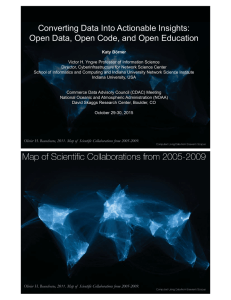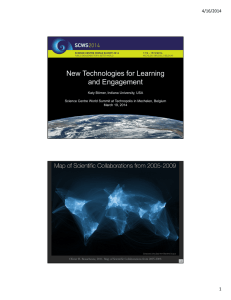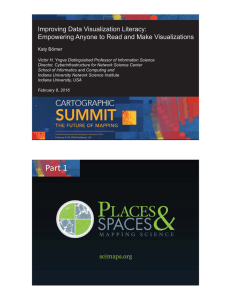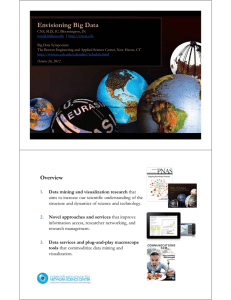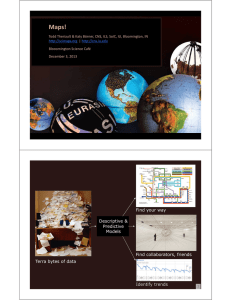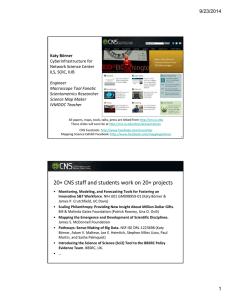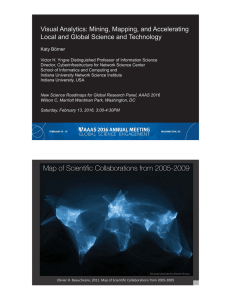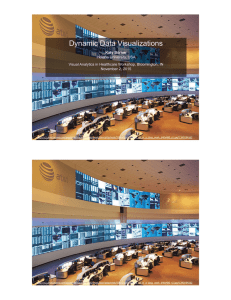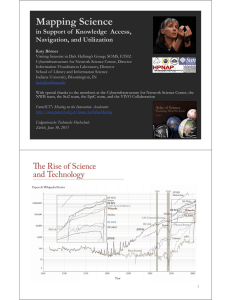Network Workbench: A CI-Marketplace for Network Scientists
advertisement
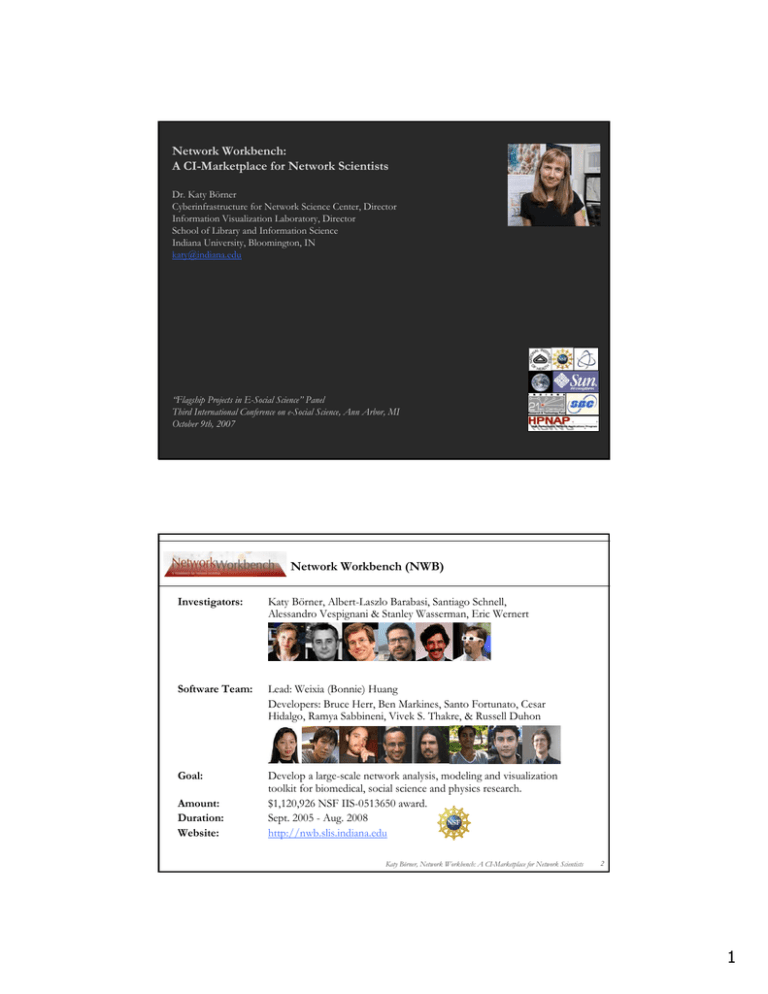
Network Workbench: A CI-Marketplace for Network Scientists Dr. Katy Börner Cyberinfrastructure for Network Science Center, Director Information Visualization Laboratory, Director School of Library and Information Science Indiana University, Bloomington, IN katy@indiana.edu “Flagship Projects in E-Social Science” Panel Third International Conference on e-Social Science, Ann Arbor, MI October 9th, 2007 Network Workbench (NWB) Investigators: Katy Börner, Albert-Laszlo Barabasi, Santiago Schnell, Alessandro Vespignani & Stanley Wasserman, Eric Wernert Software Team: Lead: Weixia (Bonnie) Huang Developers: Bruce Herr, Ben Markines, Santo Fortunato, Cesar Hidalgo, Ramya Sabbineni, Vivek S. Thakre, & Russell Duhon Goal: Develop a large-scale network analysis, modeling and visualization toolkit for biomedical, social science and physics research. $1,120,926 NSF IIS-0513650 award. Sept. 2005 - Aug. 2008 http://nwb.slis.indiana.edu Amount: Duration: Website: Katy Börner, Network Workbench: A CI-Marketplace for Network Scientists 2 1 NWB Advisory Board ¾ ¾ ¾ ¾ ¾ ¾ ¾ ¾ ¾ Ulrik Brandes, University of Konstanz, Germany (Graph Theory) Noshier Contractor, Northwestern University (Communication Theory) Mark Gerstein, Yale University (Bioinformatics) James Hendler, Rensselaer Polytechnic Institute (Semantic Web) Jason Leigh, Electronic Visualization Laboratory, University of Illinois at Chicago (Visualization & CI) Neo Martinez, Pacific Ecoinformatics and Computational Ecology Lab (Biology) Michael Macy, Cornell University (Sociology) Stephen North, AT&T (Graph Visualization) Tom Snijders, University of Groningen (Social Network Analysis) Katy Börner, Network Workbench: A CI-Marketplace for Network Scientists 3 NWB CI Deliverables Cyberglue: ¾ CIShell Core programmer team lead by Bonnie Huang Tools & Services: ¾ NWB Tool ¾ SciMaps Service ¾ Bio Tool Lead by Alex Vespignani with input from other PIs Lead by Katy Borner Lead by Laszlo Barabasi & Santiago Schnell All three are prototypical instantiations of CIShell serving as reference implementations. Documentation/Registry/Market Place: ¾ NWB Community Wiki Lead by Katy Borner Katy Börner, Network Workbench: A CI-Marketplace for Network Scientists 4 2 Embracing the Diversity of Network Science See also Börner, Katy, Sanyal, Soma & Vespignani, Alessandro. (2007). Network Science. In Cronin, Blaise (Eds.), Annual Review of Information Science & Technology (Vol. 41, pp. 537-607), chapter 12, Medford, NJ: Information Today, Inc./American Society for Information Science and Technology. Computational Social Science Studying large scale social networks such as Wikipedia Vizzards 2007 Entry Second Sight: An Emergent Mosaic of Wikipedian Activity, The NewScientist, May 19, 2007 3 113 Years of Physical Review Bruce W. Herr II and Russell Duhon (Data Mining & Visualization), Elisha F. Hardy (Graphic Design), Shashikant Penumarthy (Data Preparation) and Katy Börner (Concept) Computational Scientometrics Studying science by scientific means Börner, Katy, Chen, Chaomei, and Boyack, Kevin. (2003). Visualizing Knowledge Domains. In Blaise Cronin (Ed.), Annual Review of Information Science & Technology, Volume 37, Medford, NJ: Information Today, Inc./American Society for Information Science and Technology, chapter 5, pp. 179-255. Shiffrin, Richard M. and Börner, Katy (Eds.) (2004). Mapping Knowledge Domains. Proceedings of the National Academy of Sciences of the United States of America, 101(Suppl_1). Places & Spaces: Mapping Science exhibit, Currently on display at the American Museum for Science and Energy, Oak Ridge, TN, see also http://scimaps.org. 8 4 Illuminated Diagram Display W. Bradford Paley, Kevin W. Boyack, Richard Kalvans, and Katy Börner (2007) Mapping, Illuminating, and Interacting with Science. SIGGRAPH 2007, San Diego, CA. 5 Katy Börner, Network Workbench: A CI-Marketplace for Network Scientists 11 Computational Economics Does the type of product that a country exports matter for subsequent economic performance? C. A. Hidalgo, B. Klinger, A.-L. Barabási, R. Hausmann (2007) The Product Space Conditions the Development of Nations. Science 317, 482 (2007). 6 Computational Proteomics S. Schnell, S. Fortunato, and S. Roy (2007). Is the intrinsic disorder of proteins the cause of the scale-free architecture of protein-protein interaction networks? Proteomics 7, 961-964. 13 Computational Epidemics Forecasting (and preventing the effects of) the next pandemic. Epidemic Modeling in Complex realities, V. Colizza, A. Barrat, M. Barthelemy, A.Vespignani, Comptes Rendus Biologie, 330, 364-374 (2007). Reaction-diffusion processes and metapopulation models in heterogeneous networks, V.Colizza, R. Pastor-Satorras, A.Vespignani, Nature Physics 3, 276-282 (2007). Modeling the Worldwide Spread of Pandemic Influenza: Baseline Case and Containment Interventions, V. Colizza, A. Barrat, M. Barthelemy, A.-J. Valleron, A.Vespignani, PloS-Medicine 4, e13, 95-110 (2007). 7 Designing Cyberglue See also Herr, Bruce W., Huang, Weixia, Penumarthy, Shashikant, Börner, Katy . (2007) Designing Highly Flexible and Usable Cyberinfrastructures for Convergence. In William S. Bainbridge and Mihail C. Roco (Eds.) Progress in Convergence – Technologies for Human Wellbeing. Annals of the New York Academy of Sciences, Boston, MA, volume 1093, pp. 161-179. Building Market Places not Cathedrals ¾ ‘Software glue’ has to interlink datasets and algorithms written in different languages using different data formats. ¾ The smaller the glue or ‘CI Shell’, the more likely it can be maintained. Katy Börner, Network Workbench: A CI-Marketplace for Network Scientists 16 8 CIShell – Serving Non-CS Algorithm Developers & Users Users Developers CIShell Wizards CIShell IVC Interface NWB Interface Katy Börner, Network Workbench: A CI-Marketplace for Network Scientists 17 CIShell – Build on OSGi Industry Standard CIShell is built upon the Open Services Gateway Initiative (OSGi) Framework. OSGi (http://www.osgi.org) is ¾ A standardized, component oriented, computing environment for networked services. ¾ Successfully used in the industry from high-end servers to embedded mobile devices since 7 years. ¾ Alliance members include IBM (Eclipse), Sun, Intel, Oracle, Motorola, NEC and many others. ¾ Widely adopted in open source realm, especially since Eclipse 3.0 that uses OSGi R4 for its plugin model. Advantages of Using OSGi ¾ Any CIShell algorithm is a service that can be used in any OSGi-framework based system. ¾ Using OSGi, running CIShells/tools can connected via RPC/RMI supporting peer-topeer sharing of data, algorithms, and computing power. Ideally, CIShell becomes a standard for creating OSGi Services for algorithms. Katy Börner, Network Workbench: A CI-Marketplace for Network Scientists 18 9 CIShell – Technical Details CIShell layer cake. Katy Börner, Network Workbench: A CI-Marketplace for Network Scientists 19 CIShell – Deployment Data-Algorithm Repositories Peer-to-Peer Stand Alone Server-Client CIShell applications can be deployed as distributed data and algorithm repositories, stand alone applications, peer-to-peer architectures, and server-client architectures. Katy Börner, Network Workbench: A CI-Marketplace for Network Scientists 20 10 The NWB Tool NWB Tool: Interface Elements http://nwb.slis.indiana.edu Load Data Select Preferences List of Data Models Console Visualize Data Scheduler Open Text Files Katy Börner, Network Workbench: A CI-Marketplace for Network Scientists 22 11 NWB Ecology of Data Formats and Converters Not shown are 15 sample datasets, 45 data preprocessing, analysis, modeling and visualization algorithms, 9 services. 5 Supported data formats 5 Output formats for diverse visualization algorithms 8 Intermediate data formats Supported by 35 data converters. 12 NWB Community Wiki https://nwb.slis.indiana.edu/community/ Education – Learning Modules, NWB User and Developer Workshops 13 The End. 14
